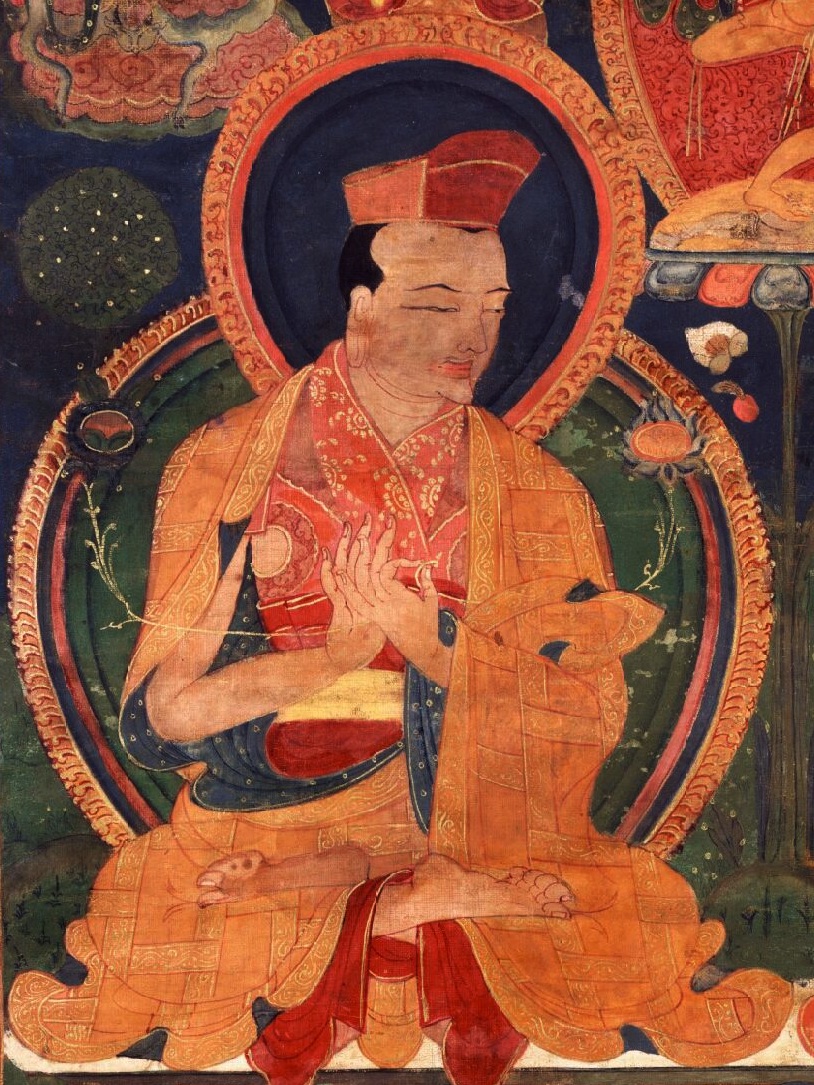Biography and autobiography in Tibet are important sources for both education and inspiration. Tibetans have kept such meticulous records of their teachers that thousands of names are known and discussed in a wide range of biographical material. All these names, all these lives—it can be a little overwhelming. The authors involved in the Treasury of Lives are currently mining the primary sources to provide English-language biographies of every known religious teacher from Tibet and the Himalaya, all of which are organized for easy searching and browsing. Every Tuesday on the Tricycle blog, we will highlight and reflect on important, interesting, eccentric, surprising and beautiful stories found within this rich literary tradition.
Part 1: Mila and Marpa
Part 2: Gampopa and Barompa
Part 3: First Karmapa and Lama Zhang
Part 4: Pakmodrupa and Gyergom Tsultrim Sengge
Part 5: Taklungtangpa and Sanggye On
Part 6: Marpa Sherab Yeshe and Jikten Gonpo
Part 7: Rinchen Gon and Jampa Pel
Part 8: Lingrepa and Tsarpa Gyare
Kagyu Founders, Part 9: Yabzang and Yelpa


For our final post on the founders of the so-called four “major” and eight “minor” Kagyu traditions—meaning those traditions that stemmed from the four students of Gampopa (1079–1153) and the eight that came from students of Pakmodrupa (1110–1170)—we will touch on the founders of one tradition, the Yabzang Kagyu, which faded quickly from history, and of another, the Yelpa Kagyu, which survived largely by virtue of the enduring popularity of the folk hero Gesar of Ling.
The Yabzang Kagyu
The Yabzang Kagyu tradition was founded by Zarawa Kelden Yeshe (c.1168–1207), a disciple of Pakmodrupa, and his disciple, Yabzang Choje Chokyi Monlam (1169–1233). As a youth, Zarawa herded goats near Pakmodrupa’s monastery of Densatil. After overhearing two hermits discuss meditation, he went over to Densatil to take instruction. There, Pakmodrupa explained to Zarawa why the youth only slept facing downwards: although in previous lives he had attained some results from his practice, he had transgressed his vows. Pakmodrupa introduced him to the nature of mind, a realization that laid the foundation for Zarawa’s establishment of a new monastery called Zara, from which his title derives.
Yabzang Choje Chokyi Monlam, Zarawa’s foremost disciple, was born into an illustrious family in the Yarlung valley, the ancient center of Tibetan government. He took novice vows at 15 and complete ordination six years later, for which he memorized the key texts of the Vinaya, the monastic codes and their commentaries. After learning of Zarawa’s presence nearby, the young monk sought him out for Mahamudra instruction, which he had heard described as the “heart of the teachings.” It is said that Yabzang had a special Mahamudra realization as soon as he saw the place where Zarawa resided.
Chokyi Monlam is remembered for taking the Kagyu teachings of Zarawa and systematizing them alongside supplementary teachings on Chod received from a grandson of Machik Labdron (1055-1149) and Zhije teachings, which he received from a disciple of Padampa Sanggye. He also studied with a Nyingma teacher named Zhikpo Dutsi (1149–1199) and he may or may not have also studied with Tsangpa Gyare (1161–1211) and Zhang Yudrakpa (1123–1193), the founders of the Drukpa and Tselpa Kagyu traditions, respectively.
In 1207, the year Zarawa passed away, Chokyi Monlam established Yabzang Monastery in the upper Yarlung Valley. Neither Zara nor Yabzang Monasteries flourished for very long, and the Yabzang Kagyu teachings were absorbed into other traditions.
The Yelpa Kagyu
Yelpa Yeshe Tsek (1134-1194), the founder of the Yelpa Kagyu tradition, was born in Kham and ordained as soon as he was of age. As was common in those days among monks of the region, he travelled to central Tibet for advanced study. Dissatisfied with the scholastic study of logic and Madhyamaka that he received at the Kadampa monastery of Sangpu, he sought out the Kagyu teachers Ngok Dode and Parpuwa Lodro Sengge, who taught him the doha song tradition that the Kagyu had brought from India. At the age of 29, he met Pakmodrupa, who started him out with the basics—the preliminary practices. It is said that in the course of his guru yoga meditations, Yeshe Tsek experienced all phenomenal objects fade into mist.
One day while meditating, it occurred to Yeshe Tsek that the time for the noon meal had arrived, and just as he was putting away his meditation band he realized the true meaning of the Madhyamaka view. After a few days pondering its significance he reported this to Pakmodrupa, who was quite pleased.
Seven years later Yeshe Tsek returned to Kham, and when he took his leave of his master he sang the following song:
In every way and at every moment
I am protected by the Lama’s light.
May the Lama bless me that I
never for one second be deprived
of the state of emptiness-compassion.
May I be free from grasping to
the illusory bodily aggregate,
may I resolve all reifications back into mind,
may all my deeds work toward dharma and
may I act constantly for the benefit of beings.
Back in his home region of Kham, Yeshe Tsek established a number of monastic centers, including Yelpuk, in 1171, which gave his teaching tradition its name and him his title. In 1188, he founded a monastery called Tana, and installed there many relics of the folk hero Gesar, the popularity of whom has essentially kept the monastery on the map for the last 900 years. At the age of 61, he gave his last teachings to his students on the topics of impermanence, the certainty of death, and the faults of samsara. His final words were, “Never at any time allow yourselves to be deprived of emptiness and compassion.” Some of Gesar’s relics survived the Cultural Revolution, when the monastery was destroyed, and have been reinstalled in the rebuilt Tana Monastery.
Thank you for subscribing to Tricycle! As a nonprofit, we depend on readers like you to keep Buddhist teachings and practices widely available.